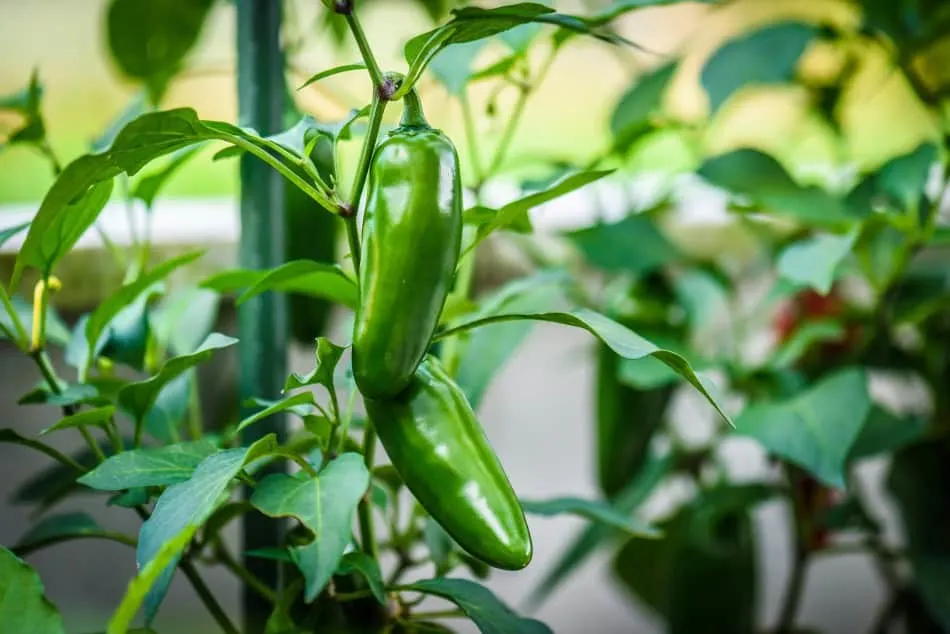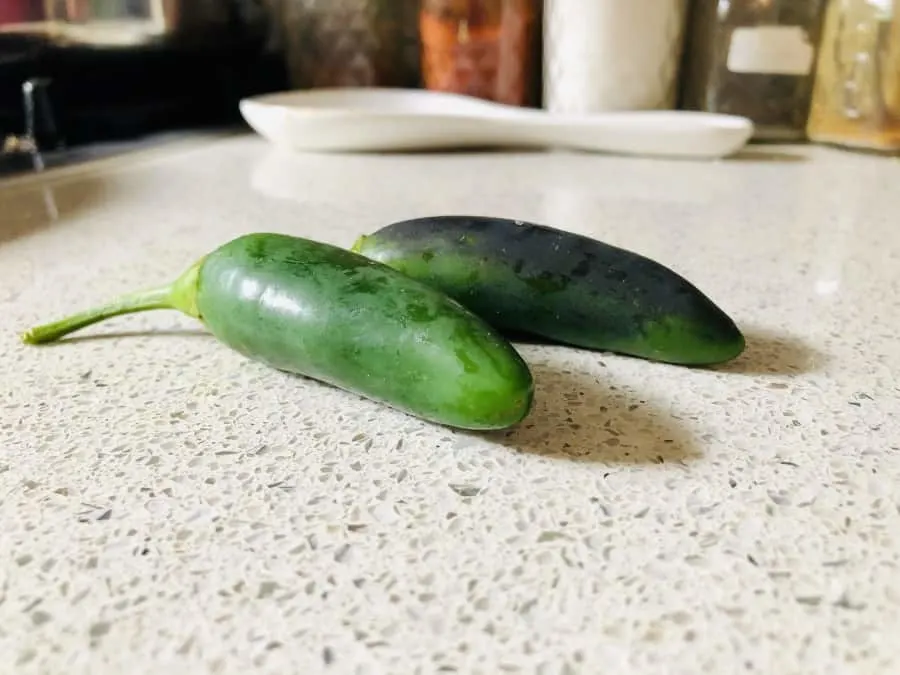Jalapeño peppers are among the more popular varieties in the hot pepper family, and it’s no surprise that many people choose to grow them at home. Luckily, taking care of them doesn’t require too much effort. However, whether you have them planted in tiny pots in the house or have an entire section devoted to them in your garden, you’ve probably wondered how you should go about pruning them.
You can prune young Jalapeño pepper plants by pinching off buds and extra foliage, to strengthen your plant’s base. In the midseason, you can use shears to get rid of rotting or diseased leaves. And in the late season, pruning can help get rid of inward-facing stems and overhanging leaves.
Before we delve into the details, it’s worth noting that pruning isn’t necessary for your pepper plants, but when done correctly, it can help boost your plant’s growth. So, if you’re after a bountiful harvest, you’d better get your gloves, pruning shears, or scissors and get to work. Here’s a step-by-step walkthrough to get you started on pruning your Jalapeño plants.

Pruning Jalapeño Pepper Plants in the Early Season
When and how you prune your Jalapeño pepper plants will depend on their growth stage. Each season will require you to prune different parts of the plant and might also require using different tools.
Here are some practices to incorporate when pruning your Jalapeño pepper plant during the early season:
Use Your Fingers, Not Shears
When your pepper plant is still young, you don’t need pruners; your hands will suffice. Hold the part of the plant you want to get rid of between your thumb and forefinger and gently snap it out of place. Be sure to dip your fingers in a powdered milk and water solution to prevent spreading bacteria and diseases as you work through the different plants.
Remove Excess Foliage
At this stage, you want to prune off the central growing point. You’ll notice that your plant adopts a ‘Y’ shape at the center stem when it’s about one foot tall. Pinch off the excess foliage above the ‘Y’ and leave a few leaves on the plant. Reducing excess foliage will help strengthen the base and promote branching.
Prune off the Early Flowers
You’re probably wondering why you should prune off the flowers if you want a bountiful harvest. However, after transplanting your pepper plants, you should primarily focus on establishing a robust root system. Removing the first flowers that appear within 2-3 weeks after transplanting helps your pepper plants develop an extensive root system quicker.
Cut Off Extra Side Shoots
When your Jalapeño plant is about a foot tall, you’ll notice some extra side shoots appearing. Gently pull them off and only leave a few main stems. This improves the air circulation and prevents fungal diseases, which are more likely to thrive on the low-lying side shoots. Additionally, it boosts the remaining leaves so they can develop fully.
Pruning Jalapeño Pepper Plants in Midseason
Remove the Lowest Leaves to Limit Pests
As was the case with the extra side shoots, you’ll want to get rid of the lowest leaves to help keep away ground pests. Ensure the lowest 6-8 inches (15.24 – 20.32 cms) of the stem are bare. At this point, you can use a sharp pair of clippers to get the job done. Using clippers at this point ensures you get a clean-cut, especially since the stems are growing studier.
Remove Damaged Leaves
There are times when your plants may be affected by diseases, regardless of how much care you put into them. If you notice anything wrong with your pepper plant, remove the affected leaves immediately. Pruning damaged leaves prevents the spread of the disease, especially if any leaves or branches are in contact with the soil.
Pruning Jalapeño Pepper Plants in the Late Season
Well, you made it through the early season when the plant was still a seedling to the midseason, where you waded off diseases successfully. Now that you’re in the late season and getting ready to harvest, it’s time to give your best last shot at ensuring your pepper plants grow to their full potential. Here’s how to carry out pruning at this stage.
Remove Inward-Facing Stems
As your pepper plant matures, some of the stems may start growing inwards. This will cause the leaves to hang over developing fruits, blocking much-needed sunlight. Sunlight helps peppers reach their mature color, which is also when they often taste the best. Encouraging your plants to grow outwards, especially at the base, also helps maintain its center of gravity, so it doesn’t topple over. This is especially a problem if your plant is planted in a pot.
Top the Jalapeño Pepper Plants
Topping requires that you prune all the pepper plant’s growing points about four weeks before the first frost. This includes pruning off the excess flowers and shoots that are still growing. Use scissors or shears to prune the top 4-6 inches (10.16 – 15.24 cms) of all branches and shoots. This step helps your plants to gain their color fully before the first frost comes around.

FAQs on Pruning Jalapeño Pepper Plants
Why Should You Prune Jalapeño Plants?
You don’t have to prune your Jalapeño pepper plants. However, it helps to keep them healthy all through and ensures a bountiful harvest. Some pepper plant types benefit more from the pruning process than others, so it’s important to find out what works for your plants. You can also test a few plants and assess the results.
What are the Benefits of Pruning Your Jalapeño Plant?
The benefits depend on what growth season your plant is at. During the early stages, pruning helps with branch formation, root production, and improving air circulation. In the midseason, pruning keeps away pests and diseases and ensures the plant doesn’t become too heavy. Pruning in the late season is primarily to help with the color formation and full development.
Is Pruning the Same as Trimming?
Although the terms can be used interchangeably, there’s a slight difference between pruning and trimming. Pruning involves removing the dead, loose, unwanted, or diseased parts of your Jalapeño plant, which mostly include buds or leaves. Trimming refers to cutting back the overgrown pepper plant.
When Should and Shouldn’t You Prune Your Jalapeño Plants?
You should always do your pruning when it is dry. Disease-causing fungi thrive during wet seasons. If you prune your Jalapeño plants during the rainy season, you risk having the fungi enter the plant through the pruning wounds.
How Much Should You Prune Jalapeño Plants?
In most cases, you only need to cut off the first 3-6 inches (7.62 -15.24 cms) of whatever part of the plant you’re pruning. However, during the early stages, you should only pinch off the unwanted buds.
If pruning out the flowers, only cut them off during the very early stages of the pepper plant’s life before and just after transplanting. Any more pruning and you risk reducing your expected harvest of peppers.
How Often Should You Prune Your Jalapeño Plant?
Pruning is an ongoing process all through the plant’s growth cycle. However, you don’t always have to prune if there’s no need to. For example, if there are no damaged or low-lying leaves during midseason, you can skip pruning at this stage altogether. Similarly, if your plant keeps producing suckers every so often, you may need to include a few more pruning sessions than usual.
What are the Best Tools for Pruning Jalapeño Plants?
You need a sharp pair of shears or scissors for pruning. However, you can get away with using your fingers when the seedlings are still very young. Rubber gloves may also be necessary to help you hold the plant securely when pruning. Wearing gloves not only protects your skin, but also protects your plant from catching diseases. This is especially important if you’re a smoker, because you could put your plant at risk of getting tobacco mosaic virus. Lastly, have a pail or bin with you to hold the clippings.
Can You Over Prune Your Jalapeño Plant?
Yes, it is possible to over prune Jalapeño pepper plants. Unlike other large-fruited pepper plants, Jalapeño plants only require little pruning, especially when removing the extra side shoots, which is why some people don’t even prune their pepper plants at all. Jalapeños have a bushier growth habit, and if you remove too many suckers, you may end up with a dismal harvest.
Closing Thoughts
You don’t have to prune your Jalapeño plants, but doing so can help boost your harvest, so you should consider doing it. Here’s a quick recap of the critical points and a few tips to go with:
- Prune during different growing seasons.
- Using your fingers to prune the young plant helps to reduce the risk of damaging it.
- Always ensure your pruning shears and scissors are clean to avoid spreading diseases to your plants. Also, use gloves when pruning if you’re a smoker to reduce the risk of tobacco mosaic virus that spreads easily.
Here are Some of my Favorite Gardening Products and Tools
Thank you for reading this article. I hope you found it helpful for growing some new plants in your home or garden. Here are some products I like that I hope you’ll also find helpful. These are affiliate links, and I am compensated for referring traffic. But in all honesty, these are the exact product that I use or recommend to everyone.
Soil: For high-quality soil, I really like Fox Farm Ocean Forest. I do all my growing in containers and this soil has worked great for me. I like how they use nutrient-rich contents like earthworm castings, bat guano, and composted crab and fish.
Fertilizer: Currently I am using a seaweed-based organic fertilizer call Neptunes Harvest. This is a great milder fertilizer option if you want to use something organic. If you want a more powerful fertilizer, I recommend Fox Farm Liquid Nutrient Trio, lots of people have had great growing success with this product.
Pruning Shears: Pruning shears are one of the most useful gardening tools to have because it’s important to prune your plants to keep them healthy. The pruning shears I recommend are the Gonicc 8’’ pruning shears. I like them because they are built sturdy and work both on bigger and smaller plants, so you don’t need to have multiple pruning shears.
spicytrio.com is a participant in the Amazon Services LLC Associates Program, an affiliate advertising program designed to provide a means for sites to earn advertising fees by advertising and linking to Amazon.com. spicytrio.com also participates in affiliate programs with other sites. spicytrio.com is compensated for referring traffic and business to these companies.
